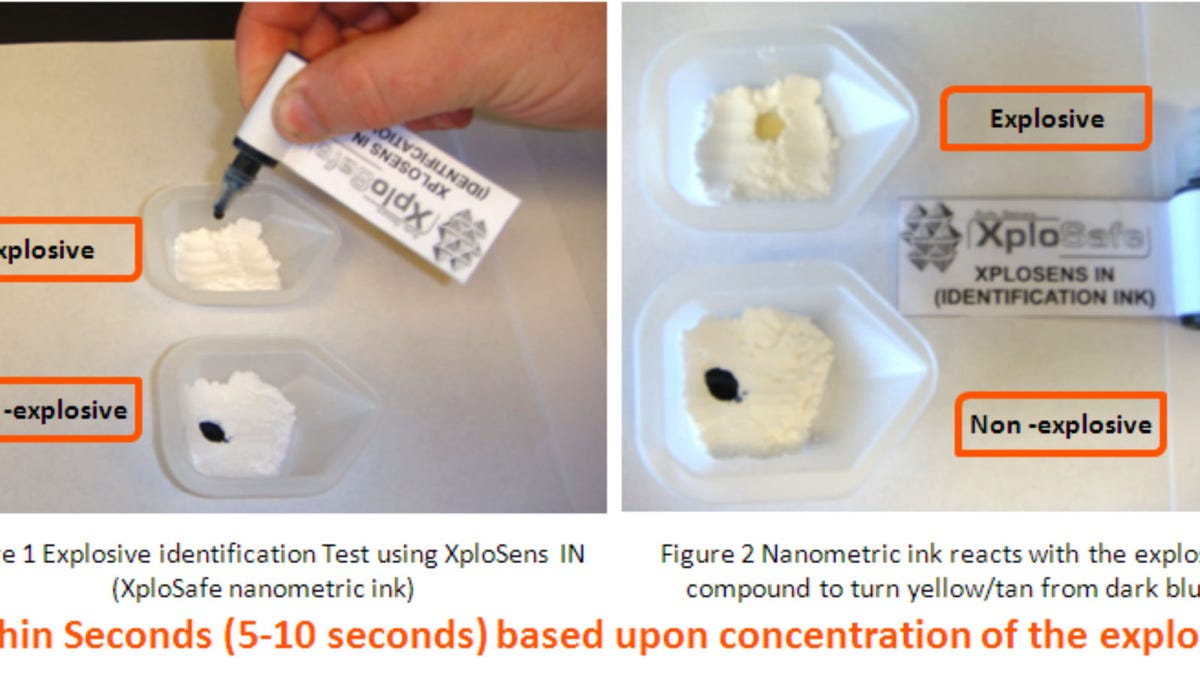New nanomaterial could detect, neutralize explosives
Scientists have come up with a material, essentially an ink, that they say could be used to safely test liquids brought on board airplanes.

If a group of scientists can get their project off the ground, there's a chance U.S. air travelers may one day be able to bring aboard more liquids in their carry-on luggage again.
The team, led by Oklahoma State University chemistry professor Allen Apblett, has come up with what it says is a nanomaterial that can both detect and neutralize some dangerous explosives. If deployed in a practical manner at airports in the U.S. and elsewhere around the world, it could, in theory, make it possible once again for some people to bring more liquids with them when they fly.
The material is essentially an ink composed of metallic oxide nanoparticles tiny enough that tens of thousands of them would barely fill out the diameter of a single human hair. In an interview yesterday, Apblett said that in one form it's a dark blue reagent that changes color when it encounters certain kinds of explosives. It can work directly, in liquids, or it can in some circumstances work in the presence of the vapors that can be let off by explosives.
And while the most prominent use of such a new technology could well be at airports, the team of scientists is also aiming to give bomb squads, hazmat crews, soldiers, and even firefighters better tools for finding and eliminating potentially destructive explosives.
Still, there's little doubt that to the flying public the potential for bringing along more liquids in their carry-on luggage again would be the most interesting development.
Some would argue, of course, that the limit on liquids hasn't improved safety at all and has done little more than inconvenience travelers. The development of the nanomaterial presents a major market opportunity for Apblett and his partners in XploSafe, the company they've formed around the discovery.
Related links
• Bomb-detecting bees work for food
• Divining rod reborn as explosive-detection device
Funded first by the Memorial Institute for the Prevention of Terrorism and later by the National Science Foundation to develop materials for the identification of improvised explosives, the team came up with several detection and neutralization products, including sprays and drops, as well as electronic monitoring systems.
Although testing liquids would be a major move forward, Apblett points out that a TSA employee examining every bottle of water or soda or infant formula that passengers might want to take with them when they fly would likely be impractical.
Instead, Apblett imagines a system where travelers are told that they can bring important liquids with them, knowing they'll have to stop for a test.
Liquids that aren't meant for human consumption would be examined on a test strip containing the nanomaterial that would change color if a peroxide-based explosive was found, while samples of those meant for drinking would be drawn into a tube, where a similar test would be performed.
At the same time, Apblett said, XploSafe has developed an area sensor that is designed to detect the vapors from peroxide high explosives. The idea here is that travelers would pass through the sensors and, if something suspicious is detected, they would be pulled aside for a secondary search.
Of course, he said, there are many things that can cause false positives, and indeed, Apblett said that he is frequently being checked by airport security thanks to the presence of chemicals from various labs that are found using current detection systems.
There are certainly other products and technologies being used or developed to try to stop would-be terrorists from bringing explosives on board airplanes. Already, the TSA has equipment that allows its workers to swipe a piece of material on someone's belongings to see if there are any traces of explosives. And an Israeli start-up called BioExplorers recently announced a system that leverages mice's strong sense of smell to potentially detect bombs or drugs.
Apblett said that explosives made with hydrogen peroxide are very likely to give off some form of vapor, though a very careful terrorist might avoid that slip-up. "The problem with trace explosives detection," Apblett said, "is that you're depending on them being sloppy."
Fortunately, he said, in many cases would-be bombers are not that careful, and that in most cases, when someone fills a container with some sort of material, traces are left on the outside. In the case of hydrogen peroxide explosives, any such traces could set off the detectors.
Given recent public outrage over new scanning systems at airports, XploSafe is clearly looking to get its new detection systems on the market as soon as possible. Already, it has some of its products for sale. But it is now working hard to get the vapor sensors ready for public use. Apblett imagines it could take six months to a year "until we have those perfected."

